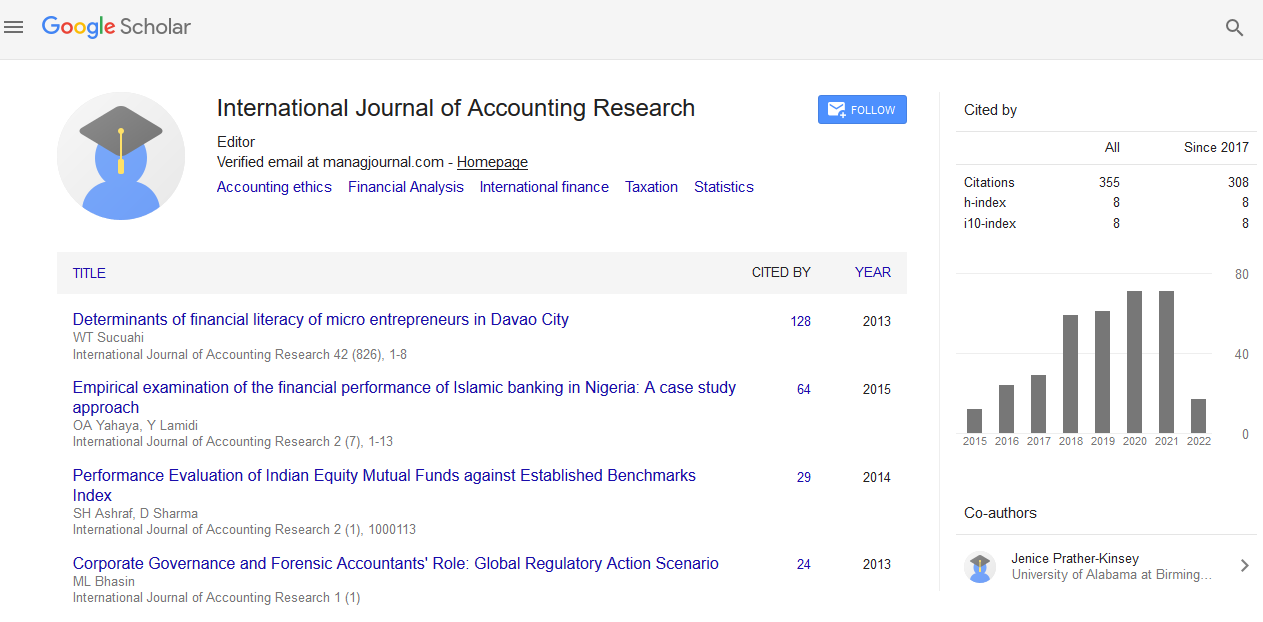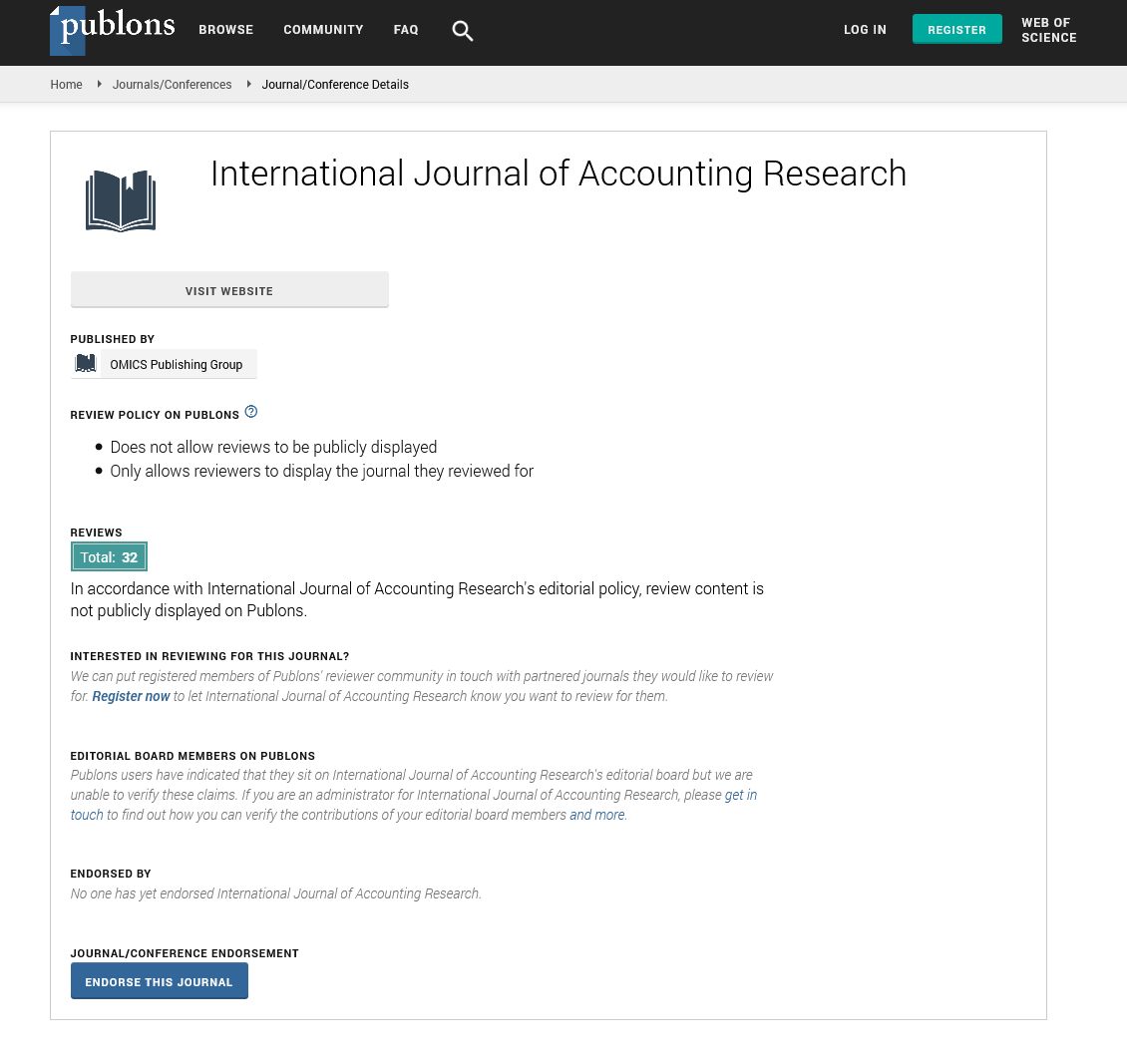Indexed In
- Open J Gate
- RefSeek
- Hamdard University
- EBSCO A-Z
- Scholarsteer
- Publons
- Euro Pub
- Google Scholar
Useful Links
Share This Page
Journal Flyer

Open Access Journals
- Agri and Aquaculture
- Biochemistry
- Bioinformatics & Systems Biology
- Business & Management
- Chemistry
- Clinical Sciences
- Engineering
- Food & Nutrition
- General Science
- Genetics & Molecular Biology
- Immunology & Microbiology
- Medical Sciences
- Neuroscience & Psychology
- Nursing & Health Care
- Pharmaceutical Sciences
Perspective - (2023) Volume 11, Issue 6
Formation and Impact: Investigating Auditor Dyads in Auditing Practice
Nelam Pavar*Received: 22-Nov-2023, Manuscript No. IJAR-23-24147; Editor assigned: 24-Nov-2023, Pre QC No. IJAR-23-24147 (PQ); Reviewed: 08-Dec-2023, QC No. IJAR-23-24147; Revised: 15-Dec-2023, Manuscript No. IJAR-23-24147 (R); Published: 25-Dec-2023, DOI: 10.35248/2472-114X.23.11.358
Description
Factors influencing and being influenced by the establishment of dyads at the top level of audit teams, dyads between concurring and lead auditors. Designers employ the sociological theory of homophily, or the innate preference for similar others, to hierarchically arranged auditor dyads. Their model studies reveal that sharing the same gender and ethnicity, as defined by dialect, boosts the likelihood of dyad formation above and above what would be expected based on the available auditor pool's features.
Forming auditor dyads of the same age is also avoided, showing that the need to establish a genuine hierarchical relationship through social distinction is a boundary condition for homophily. When utilizing an instrumental variable approach to explore the repercussions of auditor dyad formation, designers found that auditor dyads who speak the same dialect provide worse audit quality. Homophily is significant in the development of auditor dyads, which may have detrimental consequences for audit quality.
Using a mixed-methods analysis methodology, investigates the reasons that lead to the formation of dyads between concurring and lead auditors at the top of audit teams, as well as the consequences for audit quality. The auditor pair of concurring and lead auditors is hierarchically organized, as are other reviewer-reviewee dyads within audit teams. Lead auditors plan, carry out, and supervise the audit on site, while concurring auditors evaluate lead auditors' performance. Behavioral auditing research has already looked into how the design of the review process affects the outcome.
However, neither the formation nor the impact of auditor dyads are examined. Previous archive auditing research has largely ignored potential factors influencing the formation and efficacy of auditor dyads, instead focusing on the impact of individual auditor characteristics on audit outcomes. As the first step in our investigation into auditor dyads, they study the evolution and cooperation of concurring and lead auditors using archival and interview data.
Their follow the German practice of having both the lead and concurring auditors sign the audit opinion. Both choice-based and induced homophily shape social networks along lines of similarity in variables such as ethnicity, age, religion, education, occupation, and gender. When people have the opportunity to get to know one another in a social setting, such as living in the same neighbourhood or working for the same company, homophily-based relationships might form.
Auditing is a good institutional framework for investigating the role of homophily in pair formation. To begin, sociology usually focuses on relationships involving equal parties, such as friendship or marriage. In contrast, their interviews with seasoned auditors demonstrate that auditor dyads are organized hierarchically as reviewer-reviewee pairs. The literature on hierarchical organizational structure emphasizes the importance of demonstrating that hierarchical differentiation based on differences in position or power is justified. Hierarchical differentiation allows for a distinct division of labor, which improves cooperation and coordination.
This requirement may be incompatible with similarity-based interactions, reducing the significance of choice-based homophily. Second, there is a great deal of legislation around auditing, and these requirements emphasize the importance of audit team members being skilled and independent. Auditing is a good institutional framework for investigating the role of homophily in pair formation. To begin, sociology typically focuses on these criteria, and the more regulated formation processes in comparison to other contexts may diminish the impact of choice-based homophily, raising concerns about the applicability of theory and previous study findings.
Conclusion
Finally, auditor dyads are formed inside the organizational structure of an audit firm. The borders of this organizational unit limit the number of prospective auditor dyad partners. This setting allows us to explore how the number of auditors available in an audit business or audit office influences choice-based homophilous tendencies.
Citation: Pavar N (2023) Formation and Impact: Investigating Auditor Dyads in Auditing Practice. Int J Account Res. 11:358.
Copyright: © 2023 Pavar N. This is an open-access article distributed under the terms of the Creative Commons Attribution License, which permits unrestricted use, distribution, and reproduction in any medium, provided the original author and source are credited.


